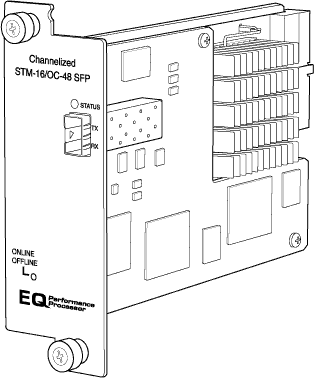|
Software release
|
|
|
Description
|
-
One OC48/STM16 port
-
SONET or SDH is configurable on a per-port granularity
-
SONET channelization:
-
4 OC12 channel
-
16 OC3 channels
-
48 DS3 channels
-
672 DS1 channels
-
975 DS0 channels
-
SDH channelization:
-
4 STM4 channel
-
16 STM1 channels
-
48 E3 channels
-
504 E1 channels
-
975 DS0 channels
-
Power requirement: 1.10 A @ 48V (53 W)
-
Model Number: PB-1CHOC48-STM16-IQE-SFP
|
|
Hardware features
|
|
|
Software features
|
-
Quality of service (QoS) per channel: weighted round-robin
(WRR), random early detection (RED), weighted random early detection
(WRED)
-
Enhanced fine-grained queuing per logical interface. See
the Junos OS Class of Service User Guide for Routing Devices for more information about class of service
features.
-
Subrate and scrambling:
-
Digital Link/Quick Eagle
-
Kentrox
-
Larscom
-
ADTRAN
-
Verilink
-
Packet buffering, Layer 2 parsing
-
M13/C-bit parity encoding
-
DS3 far-end alarm and control (FEAC) channel support
-
Local line, remote line, and remote payload loopback testing
-
Simple Network Management Protocol (SNMP): OC12, OC3 MIB,
DS3 MIB, T1 MIB
-
Dynamic, arbitrary channel configuration
-
Full bit error rate test (BERT)
-
Encapsulations:
-
Circuit cross-connect (CCC)
-
Translational cross-connect (TCC)
-
Extended Frame Relay for CCC and TCC
-
Flexible Frame Relay
-
Frame Relay
-
Frame Relay for CCC
-
Frame Relay for TCC
-
Frame Relay port CCC
-
High-Level Data Link Control (HDLC)
-
HDLC framing for CCC
-
HDLC framing for TCC
-
MPLS CCC
-
MPLS TCC
-
Multilink Frame Relay (MLFR) UNI NNI (MFR FRF.16)
-
Point-to-Point Protocol (PPP)
-
PPP for CCC
-
PPP for TCC
-
Encapsulations available only for DS1:
|
|
Cables and connectors
|
Tip:
You
can use the Hardware
Compatibility Tool to find information about the pluggable
transceivers supported on your Juniper Networks device.
The list of supported transceivers for the MX Series is located
at https://pathfinder.juniper.net/hct/category/#catKey=100001&modelType;=All&pf;=MX+Series.
|
|
LEDs
|
One tricolor per port:
-
Off—Not enabled
-
Green—Online with no alarms or failures
-
Yellow—Online with alarms for remote failures
-
Red—Active with a local alarm; router has detected
a failure
|
|
Alarms, errors, and events
|
SONET alarms:
-
Alarm indication signal—line (AIS-L)
-
Alarm indication signal—path (AIS-P)
-
Bit error rate—signal degrade (BERR-SD)
-
Bit error rate—signal fail (BERR-SF)
-
Loss of frame (LOF)
-
Loss of light (LOL)
-
Loss of pointer (LOP)
-
Loss of signal (LOS)
-
Payload label mismatch (PLM-P)
-
Remote defect indication—line (RDI-L)
-
Remote defect indication—path (RDI-P)
-
Remote error indication (REI)
-
Payload unequipped (unequipped STS at path level) (UNEQ-P)
-
Virtual container—alarm indication signal (VAIS)
-
Virtual container—loss of pointer (VLOP)
-
Virtual container—mismatch (VMIS)
-
Virtual container—remote defect indication (VRD1)
-
Virtual container—unequipped (VUNEQ)
SDH alarms:
-
Administrative unit alarm indication signal (AU-AIS)
-
Bit error rate—signal degrade (BERR-SD)
-
Bit error rate—signal fail (BERR-SF)
-
Bit interleaved parity (BIP) error B1, B2, B3
-
Higher order path—alarm indication signal (HP-AIS)
-
Higher order path—far-end receive failure (HP-FERF)
-
Higher order path—payload label mismatch (HP-PLM)
-
Higher order path—loss of pointer (HP-LOP)
-
Higher order path—remote defect indication (HP-RDI)
-
Higher order path—unequipped (HP-UNEQ)
-
Loss of frame (LOF)
-
Loss of light (LOL)
-
Loss of signal (LOS)
-
Multiplex section—alarm indication signal (MS-AIS)
-
Multiplex section—far-end receive failure (MS-FERF)
-
Multiplex section—remote defect indication (MS-RDI)
-
Multiplex section—remote error indication (MS-REI)
-
Phase lock loop (PLL)
-
Remote error indication (REI)
-
Severely errored frame (SEF)
-
Tributary unit—alarm indication signal (TU-AIS)
-
Tributary unit—loss of pointer (TU-LOP)
-
Tributary unit—mismatch (TU-MIS)
-
Tributary unit—remote defect indication (TU-RD1)
-
Tributary unit—unequipped (TU-UNEQ)
DS1 alarms:
|
|
Instrumentation (counters)
|
|

